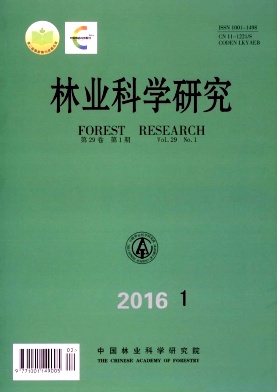|
[1]
|
Haase J, Brandl R, Scheu S, et al. Above and belowground interactions are mediated by nutrient availability[J]. Ecology, 2008, 89:3072-3081. |
|
[2]
|
Bartelt-Ryser J, Joshi J, Schmid B, et al. Soil feedbacks of plant diversity on soil microbial communities and subsequent plant growth[J]. Plant Ecology, Evolution and Systematics, 2005,7: 27-49. |
|
[3]
|
Thoms C, Gattinge A, Jacob M, et al. Direct and indirect effects of tree diversity drive soil microbial diversity in temperate deciduous forest[J]. Soil Biology & Biochemistry,2010,42:1558-1565. |
|
[4]
|
Fierer N, Strickland M S, Liptzin D, et al. Global patterns in belowground communities[J]. Ecology Letters, 2009, 12: 1238-1249. |
|
[5]
|
Merila P, Malmivaara-Lamsa M, Spetz P, et al. Soil organic matter quality as a link between microbial community structure and vegetation composition along a successional gradient in a boreal forest[J]. Applied Soil Ecology, 2010, 46: 259-267. |
|
[6]
|
Cardinale BJ, Duffy JE, Gonzalez A, et al. Biodiversity loss and its impact on humanity[J]. Nature, 2012, 486: 59-67. |
|
[7]
|
Bardgett R D, van der Putten W H. Belowground biodiversity and ecosystem functioning[J]. Nature, 2014, 515: 505-511. |
|
[8]
|
Tscherkoa D, Hammesfahr U, Zeltner G, et al. Plant succession and rhizophere microbial communities in recently deglaciated alpine terrain[J]. Basic and Applied Ecology, 2005,6:367-383. |
|
[9]
|
Andersen R, Grasset L, Thormann M N, et al. Changes in microbial community structure and function following Sphagnum peatland restoration[J]. Soil Biology & Biochemistry, 2010, 42,291-301. |
|
[10]
|
Vázquez F J, Acea M J, Carballas T. Soil microbial populations after wildfire[J]. FEMS Microbiology Ecology, 1993,13: 93-103. |
|
[11]
|
Fontúrbel MT, Barreiro A, Vega J A, et al. Effects of an experimental fire and post-fire stabilization treatments on soil microbial communities[J]. Geoderma, 2012,191:51-66. |
|
[12]
|
白爱芹,傅伯杰,曲来叶,等,大兴安岭火烧迹地恢复初期土壤微生物群落特征[J].生态学报,2012,32(15): 4762-4771.
|
|
[13]
|
郑 琼,崔晓阳,邸雪颖,等.不同林火强度对大兴安岭偃松林土壤微生物功能多样性的影响[J].林业科学,2012,48(5)95-100.
|
|
[14]
|
中国湿地植被编写委员会.《中国湿地植被》[S].北京:科学出版社1999.
|
|
[15]
|
Frostegård A, Bååth E, Tunlid A. Shifts in the structure of soil microbial communities in limed forests as revealed by phospholipid fatty-acid analysis[J]. Soil Biology & Biochemistry, 1993, 25: 723-730. |
|
[16]
|
Bååth E. The use of neutral lipid fatty acids to indicate the physiological conditions of soil fungi[J]. Microbial Ecology, 2003, 45: 373-383. |
|
[17]
|
Frostegård Å, Tunlid A, Bååth E. Use and misuse of PLFA measurements in soils[J]. Soil Biology & Biochemistry,2011,43, 1621-1625. |
|
[18]
|
Balser TC, Wixon D. Investigating biological control over soil carbon temperature sensitivity[J]. Global Change Biology, 2009,15:2935-2949. |
|
[19]
|
甘秋妹,孙海龙,郑 红,等.大兴安岭不同退化阶段土壤和植物C、N、P浓度及其化学计量特征[J].森林工程,2013,29(3): 1-5.
|
|
[20]
|
刘银良,闫敏华,孟宪明, 等.大兴安岭森林火灾对沼泽土壤的影响[J].地理科学,1995,15(4):378-384.
|
|
[21]
|
Joergensen R G, Wichern F. Quantitative assessment of the fungal contribution to microbial tissue in soil[J]. Soil Biology & Biochemistry, 2008, 40: 2977-2991. |
|
[22]
|
Carrasco L, Gattinger A, Flieβbach A, et al. Estimation by PLFA of microbial community structure associated with the rhizosphere of Lygeum spartum and Piptatherwn miliaceum growing in semiarid mine tailings[J]. Microbial Ecology, 2010,60: 265-271. |
|
[23]
|
Fang J, Barcelona M J, Alvarez P J. A direct comparison between fatty acid analysis and intact phospholipid profiling for microbial identification[J]. Soil Biology and Biochemistry, 2000, 31:881-887. |
|
[24]
|
Thiet R K, Frey S D, Six J. Do growth yield efficiencies differ between soil microbial community differing in fungal: bacterial ratios? Reality check and methodological issue[J]. Soil Biology and Biochemistry, 2006,38: 837-844. |
|
[25]
|
Vries de F T, Hoffland E, Van Eekeren N, et al. Fungal/bacterial ratios in grasslands with contrasting nitrogen management[J]. Soil Biology and Biochemistry, 2006, 38:2092-2103. |
|
[26]
|
Diedhiou S,Dossa E L,Badiane A N,et al.Decomposition and spatial microbial heterogeneity associated with native shrubs in soils of agroecosystems in semi-arid Senegal[J]. Pedobiologia, 2009,52: 273-286. |
|
[27]
|
张 莉,党 军,刘 伟,等.高寒草甸连续围封与施肥对土壤微生物群落结构的影响[J].应用生态学报,2012,23 (11):3072-3078.
|
|
[28]
|
Marschner P, Kandeler E, Marschner B. Structure and function of the soil microbial community in a long-term fertilizer experiment[J]. Soil Biology and Biochemistry, 2003, 35: 453-461. |
|
[29]
|
Opelt K , Berg C, Schönmann S, Eberl L, Berg G. High specificity but contrasting biodiversity of Sphagnum-associated bacterial and plant communities in bog ecosystems independent of the geographical region[J]. The ISME Journal, 2007, 1, 502-516. |
|
[30]
|
Preston M D, Smemo K A, McLaughlin J W, et al. Peatland microbial communities and decomposition processes in the James Bay Lowlands, Canada[J]. Frontiers in Microbiology, 2012,3,1-15. |
|
[31]
|
Pratt B, Riesen R,Johnston C G. PLFA Analyses of Microbial Communities Associated with PAH-Contaminated Riverbank Sediment[J]. Microbial Ecology, 2012,64:680-691. |
|
[32]
|
丁维新,蔡祖聪.土壤甲烷氧化菌及水分状况对其活性的影响[J].中国生态农业学报, 2003,11(1):94-97.
|
|
[33]
|
倪永清,史学伟,郑晓吉,等.冻土甲烷循环微生物群落及其对全球变化的响应[J].生态学报,2011,31(13):3846-3855.
|
|
[34]
|
Hebel C L, Smith J E, Jr Cromack K. Invasive plant species and soil microbial response to wildfire burn severity in the Cascade Range of Oregon[J]. Applied Soil Ecology, 2009, 42:150-159. |
|
[35]
|
Wang M, Qu L Y, Ma K M, et al. Soil microbial properties under different vegetation types on Mountain Han[J]. Science China Life Sciences, 2013, 56: 561-570. |





 DownLoad:
DownLoad: